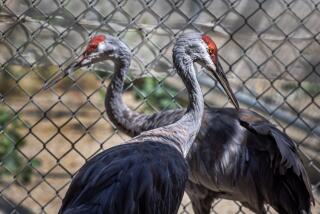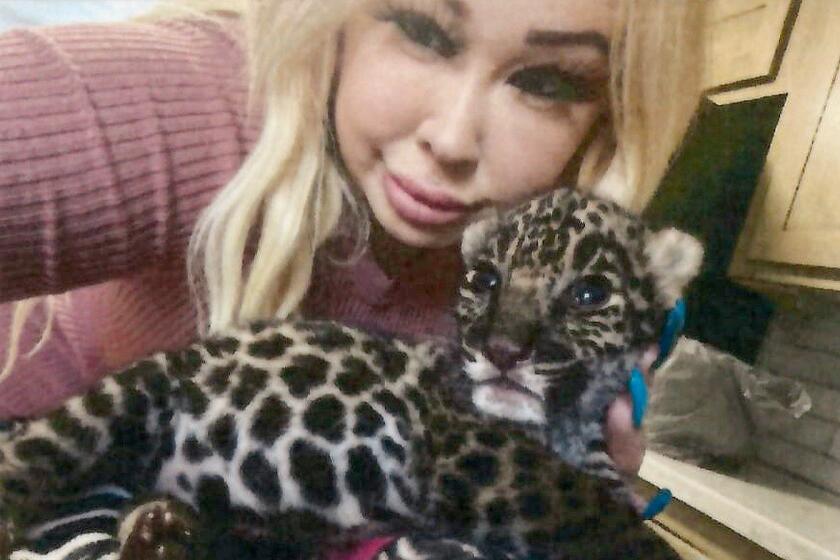6 Condors Airlifted to Site Near Fillmore : Wildlife: The zoo-hatched chicks are moved to a simulated cave where they’ll be monitored until their release in a few months.
Six young California condors were flown by helicopter Monday to a cave-like enclosure high in the rugged Ventura County backcountry in preparation for their release into the wild in the next few months.
The birds, which were all hatched and raised at the Los Angeles Zoo, were carried from their zoo quarters draped in black cloth to minimize their exposure to humans.
They will join Xewe (pronounced GAY-wee), a 17-month-old California condor that was one of the first two of the endangered species to soar in the wild since the last of the giant vultures was captured in 1987.
The second condor released in January, Chocuyens (pronounced Cho-KOO-yenz), died Oct. 8. Biologists are still waiting for toxicology and other test results to determine the cause, wildlife scientists at the Los Angeles Zoo said Monday.
The six new chicks, four females and two males ranging in age from 5 to 7 months with wingspans of more than nine feet, will be held in the same simulated cave that U. S. Fish and Wildlife biologists built for Xewe and Chocuyens last year.
The enclosure, with a net-covered porch and an electrified fence to keep out bears and other intruders, is situated atop the 150-foot-tall Arundell Cliff in the Sespe Condor Sanctuary, about 20 miles north of Fillmore. There, the birds will be monitored by federal biologists on 24-hour watches until they are released in December or January.
After heavy morning fog delayed the flights from the Los Angeles Zoo by more than two hours, Ventura County sheriff’s helicopters took to the air carrying the six chicks in three groups of two. On board each of the flights was at least one veterinarian and one biologist.
Michael Wallace, curator of birds for the Los Angeles Zoo and a member of the Condor Recovery Team assembled by the U. S. Fish and Wildlife Service, rode along on the last of the 40-minute, 50-mile flights to the sanctuary in Los Padres National Forest.
“It was exhilarating,” Wallace said. Because the birds were familiar with each other, they were “exploring and eating and a lot more relaxed than last time, when they were hissing and snapping at each other.”
The goal of the recovery program is to eventually establish three separate populations of 150 birds each--in the Sespe Condor Sanctuary, at the zoo and a third at the Grand Canyon. Once that population level is achieved, the U. S. Fish and Wildlife Service would move to take the birds off the endangered species list.
David Clendenen, a biologist with U. S. Fish and Wildlife, said after Chocuyens’ death that some mortality is expected in this kind of a program.
“I think we expected birds to die through the whole thing,” he said. “You’re a fool if you go into something like this expecting that everybody is going to make it.”
Wallace said the wild is a rough environment for the young and inexperienced birds.
“They’re like little kids running around putting everything into their mouths,” he said.
Once the cause of Chocuyens’ death has been established, scientists will try to either remove the element from their environment or educate the birds to steer clear of it.
Scientists are trying to capture Xewe to examine her. They plan to release two Andean condors to keep Xewe company before the other California condor chicks can be let free.
The carrion-eating California condor, which once numbered in the thousands, was on the brink of extinction when scientists decided in 1986 to capture the last of the wild birds. AC-9, the father of Xewe, was captured on Easter Sunday, 1987, marking the first time since the Pleistocene era up to 2 million years ago that no condors flew in North American skies.
The birds were killed by hunters and lead poisoning, which they contracted by eating the carcasses of animals that had been shot and left for dead. One condor died when it crashed into a power pole.
Since the captive breeding program produced its first chick in 1988 at the San Diego Wild Animal Park, the number of California condors has increased to 63, including the seven in the Sespe sanctuary.
James Waltman, a wildlife specialist with the National Audubon Society in Washington, said Monday that Audubon supported the release efforts of the program, despite the group’s opposition to the effort at its inception.
But he cautioned that reintroducing the animals to soar in the 53,000-acre Sespe Condor Sanctuary will be a wasted effort if the birds’ range is not adequately protected from development and encroachment by man.
“We’re very excited to get them back into the wild, but if habitat is not protected, it won’t do any good,” he said.
In July, Xewe was threatened when a Los Angeles County man on an outing to the Los Padres National Forest took three shots at the bird as it roosted on a cliff. Xewe was unharmed, but the incident alarmed scientists with the recovery program.
Wallace agreed with Waltman that more work is needed on educating the public about the birds.
“We didn’t even have no-shooting signs posted in the area where Xewe was shot at,” he said.
Condor Names
The six California condors taken from the Los Angeles Zoo to Ventura County have all been assigned Chumash Indian names. They are:
* Haku, pronounced Ha-coo, meaning hello. A female.
* Pitashi, pronounced Pi-tah-she, meaning understanding. A female.
* Hutash, pronounced Who-tosh, meaning Earth. A female.
* Koyo, pronounced Ko-yoa, meaning beginning. A female.
* Sqap, pronounced Ssh-kap, meaning feather bundle. A male.
* Niko, pronounced Knee-co, meaning water. A male.
More to Read
Sign up for Essential California
The most important California stories and recommendations in your inbox every morning.
You may occasionally receive promotional content from the Los Angeles Times.










